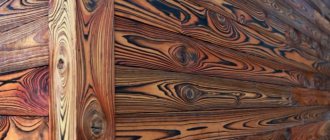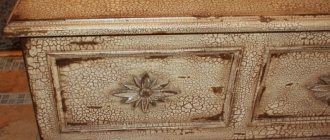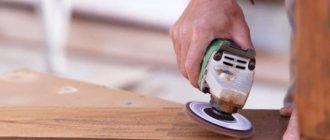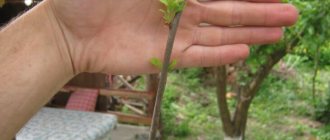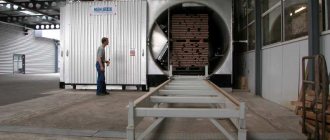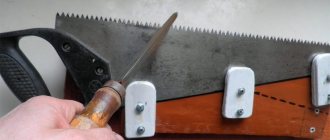What is the brushing process?
Brushing is the artificial aging (aging) of wood using various devices and special techniques. The whole process of work consists of removing the soft top fibers of wood using a hard, metal brush.
The use of brushing opens up enormous possibilities for changing the texture and color of a wide variety of wood types. Special tinting allows you to express the effect of patina, when the main wood is painted in one tone, and the pores of the wood in a completely different one.
The trees that are most easily susceptible to artificial aging are: walnut, larch, ash, oak and wenge:
Brushed walnut wood Brushed larch wood Brushed ash wood Brushed oak wood Brushed wenge wood
Beech, maple, alder, pear, and cherry are practically not used for brushing. Using the brushing technique, you can end up with a tree with a completely unusual color. Dyes used include black, purple, orange, red, white, and green.
During the process of artificial aging, the desired wood is also subjected to special treatment necessary to protect the material from pests and rot. After painting, the workpieces are polished or varnished. Brushed wood is widely used in the manufacture of furniture; it is often used to decorate the interior walls of houses and create various accessories.
The advantages of artificially aged wood include:
- Unusual and most fashionable appearance of the material.
- Wood resistance to rot and various insects.
- The ability to independently create exclusive items. The appearance of such products can be rated a solid five points; they not only favorably emphasize the exclusivity of any interior, but also look quite expensive and luxurious.
- Decorative finishing of simple tree species allows you to create an artificial imitation of exotic wood species, while the cost of the product will always be significantly lower.
The brushing process requires the use of special tools, and it is necessary to follow all the technology for working with wood. The ease of making specially aged wood yourself can be rated four points, but only if you have sufficient experience and all the necessary equipment when working with wood.
The video shows the process of brushing or aging wood:
Do-it-yourself wood brushing
If you really want, you can make artificially aged wood yourself:
- The selected workpiece needs to be slightly moistened, this will eliminate the release of wood dust during work. First, the workpiece is processed with a hard metal brush. Its rigidity is selected experimentally. It is necessary that the brush removes soft surface fibers well, but does not disturb the structure of hard fibers. The movement of the brush attached to the grinding machine or grinder is carried out in the direction of the fibers. The rotation speed is also pre-selected on the sample; for each wood the speed can vary significantly. When working manually, there are no problems with selecting the rotation speed of the brush, but the process of preparing wood becomes significantly more complicated and lengthened.
- After using a wire brush, use abrasive bristles. Using this attachment or brush, all fiber fragments and roughness are removed. At this stage, using a chisel, you can further add various indentations and grooves. They can be given the appearance of natural cracks in wood.
- In the future, final polishing is necessary, this is usually done using a brush with sisal bristles. You can use sandpaper by hand. At this stage it is necessary to achieve perfect polishing of the entire surface.
- The part acquires a special decorative appearance if it is tinted, painted, or gilded at the final stages. Stain is often used. Impregnation with stain and its quick removal allows you to paint areas with the softest fibers, while the hard ones are practically not stained.
- Painting with gold or silver paint gives the wood an original look. When applying the dye, particles of coloring pigment get clogged into microcracks, which ensures the appearance of glare in sunny weather. You can use different dyes for painting, but they must be designed for working with wood. After painting, it is recommended to polish the surface again, this will remove roughness from the product.
- At the last stage, you need to apply several layers of varnish. Before applying a layer of varnish, the previous one must dry well and it must also be polished.
Read also: Why does the thickness gauge show 0
With sufficient experience, the process of brushing wood and using special devices is not particularly difficult. At the same time, it is possible to produce the most exclusive products, ranging from wall shelves to cabinets and kitchen units.
This video will tell you how to age wood yourself:
Basic materials:
- plywood 15 mm;
- any timber with a thickness of 60 mm;
- board 30x100 mm;
- shaft 12 mm;
- shaft 10 mm;
- 20 bolts M6 30 mm;
- 6 flange support bearings with an internal diameter of 12 mm;
- 4 bearings with an internal diameter of 12 mm;
- 2 flange bearings with an internal diameter of 10 mm;
- electric motor 750W;
- M12 pin;
- steel pipe d 52 mm;
- sanding belt 100x1200 mm;
- small 12V electric motor with reduction gear;
- 2 bolts M12 90 mm.
When producing a machine according to the proposed drawing, laths and beams of non-standard sizes are used, so cutting the wood will have to be done independently on a circular table with a stop. Timber with a thickness of more than 60 mm can be used as the raw material for cutting.
Burning
Wood is fired during self-decoration and at an intermediate stage.
After the initial removal of soft fibers, it is recommended to go through a gas burner once to get rid of residual fibers, dry the wood and place emphasis on the hard structure - emphasize the ridges and wavy lines.
This is an inexpensive way to color wood, but many people do without firing and use tinting. Pine and spruce are best treated with fire.
Note!
Do-it-yourself sliding wardrobe - manufacturing manual with a full description of the stages, types of structures, choice of manufacturing materials (photo + video)
Do-it-yourself carriage screed: step-by-step instructions for creating it yourself, diagrams and drawings for beginners, selection of materials and tools (photo + video)
DIY stool - types of stools, manufacturing materials, step-by-step master class with simple diagrams and drawings for beginners
When brushing wood with your own hands by firing, the algorithm of actions is as follows:
- Burn the surface evenly and shallowly, burn the resin in the knots until completely evaporated.
- Use a hand brush to walk along the fibers (moving away from you and forward).
- Remove any remaining soft fibers with a stiff brush (like a flute).
- For a deeper and more prominent structure, re-firing.
Main production stages
The entire brushing cycle consists of sequentially performed operations:
- At the initial stage, the upper surface of the wood is processed using brushes with metal bristles. This process removes the softest, outer fibers of the wood.
- Next comes grinding. This is achieved by using a polymer, abrasive brush or using sandpaper with large grains.
- After the preparatory stages, stain or other necessary dyes are used. It is the correct use of dyes that allows you to achieve the desired antique effect.
- After the treated wood has dried, the surface is polished and multi-layered with varnish.
Aging wood at home
Brushing wood, if necessary, can be done entirely at home yourself. You will need to purchase special metal and abrasive brushes, grinding devices, dyes and varnish. In production, artificial aging is carried out using special grinding machines and other devices that facilitate the entire work process.
Automation of the entire brushing cycle allows you to reduce the price of the resulting products. The cost of artificially aged wood in production can be estimated at five points, since at home this process is somewhat delayed and requires some effort.
The photo shows what you might need to work with wood
Is it really that simple?
No, not all of them. Of course, if a small part is being textured, for example, the lid of a wooden box, there will not be any particular difficulties. But when processing large surfaces or mass production of parts, a technology that seems simple at first glance reveals many pitfalls.
What should you be prepared for?
- When working with large volumes of wood, the performance of a conventional drill or angle grinder is often not enough. Working under wear increases the likelihood of tool failure. This problem is partly solved by reducing the speed, but this is reflected in a decrease in process productivity.
- Holding a tool operating at maximum speed requires considerable physical effort. The brushing process itself is very long and requires constant monitoring, otherwise the uniformity of the relief cannot be guaranteed; Another common defect is the appearance of burns.
- Working with resinous wood has its own specifics. Due to high friction, brushing brushes heat up the surface being treated. This leads to resin bleeding, which adds headaches during the work and finishing stage.
Benefits of processing
Wood processed using brushing technology has a number of advantages.
Among the main ones are the following:
- Durability . All soft fibers are removed. As a result, only hard ones experience physical stress. Thanks to this, a product made from brushed material is stronger and lasts longer.
- Protection . By changing the structure of the top layer of wood fibers, the material is better saturated with protective compounds against bacteria, fungi and pests - they penetrate much deeper. Thanks to this, the wood is less susceptible to the effects of these adverse factors.
- Appearance . Brushed wood has a very interesting texture. Thanks to it, the material has an unusual, attractive appearance that can decorate any interior.
Brushing is a technology for aging wood that anyone can do
Designing interior items in accordance with the style of the room is one of the integral tasks of designers in our time. The method of giving wood an aged look using various means has become especially popular.
This is explained by the fact that in the age of cars and fairly dense urban development, natural materials, such as wood, are a kind of island of safety for humans - their connection with nature. This can be achieved using brushing, which has its own secrets and features.
Brushes and other tools
The main work when brushing is done with brushes. These are fairly coarse metal disc-type brushes with brass or steel bristles. It is desirable that the brush has a wide end part and is close in shape to the roller - this way the processing will be more uniform. The thickness of the wire depends entirely on the type of wood: the pile should be 7–10 times thinner than the soft veins, while straight wires are preferable to “curly” ones.
The brushes select the bulk of the fibers, but the surface remains too rough and fleecy. The quality of processing can be improved with the help of synthetic nylon brushes, in which abrasive powder of different fractions is fused into the thickness of the plastic. This type of sanding helps eliminate most of the small nicks and lint that interfere with painting; without them, the surface looks cleaner and more pleasant.
The third stage of processing is usually avoided, but if you want a premium surface quality, then brushed wood will have to be polished. Due to the presence of pores, this is not easy to do; it is necessary to use brushes with hard natural bristles, for example, sisal or coarse wool.
Good processing quality is achieved, as a rule, when using power tools. A drill will be preferable to an angle grinder; when working with it, it is easier to control the direction of grinding and speed. Careful fixation of the workpiece is also necessary; a pair of clamps will come in handy. And, of course, you will need means of protection against dust, which is generated more than abundantly, and its removal: a vacuum cleaner, glasses and gloves will definitely not be superfluous.
Brands of woodworking products
Tools for working with wood are produced by both domestic and foreign companies. The most popular companies in the Russian market these days are Interskol, Makita, Jet and Triton.
Brushing wood with JET 10-20 Plus
Interskol is a domestic brand that has existed since 1991. The tools that the company produces are presented in different CIS countries and are in certain demand. The products of the Interskol company are gaining more demand every year, which is why the company is expanding its range. Brushing with Interskol
One of the leaders among the world's woodworking companies is the Japanese company Makita, founded at the beginning of the last century. Its product range includes more than a thousand items, ranging from drills and screwdrivers to machine tools and laser equipment. Brush sander Makita 9741
Cheaper tools are sold by domestic Russian companies, such as Interskol. In addition, such instruments are easier to obtain, as they are popular in the country. Foreign companies, including Makita, do not present their entire range on the Russian market, but it can be ordered without problems through official dealers and regional distributors.
A drill with a metal attachment is suitable for the home handyman.
If wood aging occurs on a large scale, you can create a special machine that will semi-automatically carry out this process. You can create it yourself or order it, for example, from Jet. Russian Interskol does not manufacture such mechanisms. The cost of such a mechanism will be quite impressive, since the machine efficiently simultaneously performs several brushing processes. It is also very important that only removable products can be used on it. If the floor or wooden part of a complex configuration is aging, the machine will not help.
Patination
Another fairly simple method of aging wood, which can be used independently, is patination.
This method is easier to perform than brushing:
- First, the desired wooden surface is protected, sanded and carefully coated with a layer of primer.
- A base layer of the desired paint is applied to the dried surface. The first layer must dry thoroughly, usually this happens within 24 hours.
- After drying, it is cleaned and a new layer is applied. At the second stage, bronze or gold can be applied over the paint, and this can be done in individual areas. This is how the aging effect is achieved.
- To consolidate the aging effect, a layer of varnish is applied over the paint. It can be glossy or matte.
What wood is suitable for brushing?
It is better not to use rocks with a fine-fiber structure for this purpose. In order for aging wood to bring the desired effect, you need to take a material with a natural texture, in which layers with different degrees of hardness are clearly visible. Perfect for brushing:
- ash;
- larch;
- wenge;
- nut;
- pine;
- dussia;
- merbau;
- oak.
Wood unsuitable for brushing:
- maple;
- teak;
- cherry;
- alder;
- beech;
- birch;
- pear.
Processing, painting, patination
Texturing wood is only half the battle. Brushing has the ultimate goal of visually highlighting the wood texture; most often, this is achieved by painting using special techniques.
You need to make sure that the fiber selection is done well and the surface is ready for painting. For this purpose, water-based stains are used with a light tanning or cauterizing effect. Application should be done with a brush, carefully wiping along the fibers and monitoring the lifting of small fibers in the process. If such are present, the surface must be thoroughly dried and lightly treated again with a grinding brush, breaking off dried and hardened burrs.
Instead of a brush, it is convenient to use a soft sponge - the paint is distributed more evenly and without excess
When painting, most often the arrangement of tones repeats the play of light and shadow on irregularities: depressions are painted in a dark color, ridges in a light color. To do this, the surface is first opened with a richly dark varnish, and then wiped with a sponge or rag, removing the remaining varnish from the hard fibers, where it does not have time to be absorbed.
When working on a large surface, uniform coloring is achieved after complete drying of the dark dye and subsequent light processing with a petal disc with grit P400–800. When the bulges are highlighted, they are opened with colorless or light-colored parquet varnish.
Another coloring option offers inversion: the upper tier of the relief is planned to be dark, and the depressions are painted in a light tone. In this case, the surface is first tinted with dark polyurethane varnish and dried. This is followed by the application of a light opaque composition, the excess of which is removed with a rubber spatula to reveal the dark substrate on the ridges.
How to achieve the look of aged wood
So what is wood brushing and how is this effect achieved?
Naturally
Under the influence of time, sun, water and other physical and chemical processes, the softer layers of wood gradually become thinner. The spaces between the growth rings become deeper.
The veins themselves remain hard and look more prominent. The sun gives the surface a characteristic color, further emphasizing the structure of the tree. Naturally, this process is very lengthy. Finding similar interior and decor items is very difficult.
Under production conditions
To obtain the desired look, the top layer of the wooden surface is removed. In production, this result is achieved using special brushing machines, with replaceable brushes of varying hardness or sandblasting machines. In the first case, a more pronounced effect is obtained, in the second - having a relief appearance, the surface remains smoother to the touch. With industrial brushing using machines, the desired appearance of a wooden surface is achieved within a few hours.
With your own hands
In general, the name of the process itself comes from the English word brush. That is, in essence, this is surface treatment with brushes of varying hardness. The wood brushing technology itself is not that complicated. It consists of the gradual removal of softer layers of wood from the surface of the workpiece and its subsequent tinting. At home, you can make something with an aged surface in a period of several hours to several days, depending on the amount of work. The result is a unique, high-class item.
How to acquire items made from brushed wood
You can get similar decor and interior in three ways:
- buy in an antique store,
- order work on brushing a wooden surface,
- brush wood with your own hands.
Read also: Malfunctions of the resanta welding machine
The first option is for people who can afford not to save on anything. Antique furniture is a high-class pleasure and very expensive.
The second option is much more economical. However, ordering industrial aging of wooden surfaces will require certain investments.
But, as mentioned above, you can artificially age a wooden object with your own hands at home. In this case, the costs will be minimal; as a rule, every man has the necessary tools. In this case, the time will be spent usefully and with pleasure.
Safety precautions
When performing brushing, you must follow safety regulations. Working with a gas burner and grinder requires caution and precision movements. When performing all work, it is recommended to wear safety glasses, a respirator and gloves.
To clearly see how to age wood with your own hands correctly and consistently, see “Brushing wood with your own hands. Video".
Types of brushing
To obtain a more textured surface, a mechanical brushing method is suitable.
There are two ways to process a tree to reveal its structure:
- Mechanical. The wood is treated with a special tool that removes soft fibers and devices for polishing the surface.
- Chemical. It involves treating wood with special compounds (alkalies, acids, etc.) that corrode soft fibers.
The use of these types of brushing allows you to achieve different results. The mechanical method produces a textured surface, while the chemical method produces a smoother surface.
One of the techniques used by craftsmen is a combination of chemical and mechanical processing. The wood is rough processed using a chemical method, removing soft fibers. Further finishing and polishing is done mechanically.
Burning
Brushing by annealing gives the surface greater strength
One type of brushing is burning wood to remove soft tissue. The wood is burned with a blowtorch or gas torch, then washed and coated with oil polishing compounds.
With this brushing option, there is no need for subsequent tinting of the product, since the wood acquires a dark shade. If desired, burnt wood can be coated with colored stain.
About invoicing technologies
Various technologies are used to texture wood. The choice of one method or another is determined primarily by the volume of work and the characteristics of the workpieces. There are several techniques for aging wood.
Brushing with a hand tool is the most primitive technology based on the use of a brush with stiff metal bristles. This method provides shallow texturing of the surface and is quite labor-intensive. But it is great for single-piece production of small parts.
Brushing with an electromechanical tool is the most widespread, affordable and productive technology that is used for texturing boards in home and industrial settings. The main tool for selecting soft fibers is brush attachments on a grinder or drill, as well as special brushing machines.
Brushing on machines is an industrial technology aimed at mass production of parts. In one pass through the machine, the wooden workpiece is subjected to a full brushing cycle - processed with metal, grinding and polishing brushes.
Sandblasting is a less popular technology in which surface wood fibers are removed not with metal brushes, but with a jet of sand supplied under pressure. The texture has soft variations, deep relief and does not require additional sanding. The technology is focused on industrial volumes.
What you need for do-it-yourself brushing
Tools needed for brushing wood:
- workpiece to be processed
- iron brushes (or a drill with round attachments in the form of iron and polymer brushes),
- brushes with synthetic bristles,
- sandpaper,
- burner,
- nail,
- stains, paints, varnish.
Don't forget about personal protective equipment . To protect your eyes from flying small shavings and wood dust, you will need special glasses. And to avoid injury to the skin of your hands, it makes sense to work with fabric gloves.
Facade cladding with brushed clapboard
To finish the facade you will have to stock up on time and patience - this process is not quick. First you need to make sure that all bricks, window and door elements are held tightly. You can fix the lining with nails, self-tapping screws, staples, clamps, and the specific method of fastening must be chosen in advance in order to prepare the tool:
- for self-tapping screws - drill, screwdriver;
- for nails - a special air nailing gun;
- for staples - a construction stapler;
- for clamps - a hammer or screwdriver, drill, screwdriver, additionally - nails or self-tapping screws.
Also, to cut out the panels you will need a jigsaw, a tape measure, a square, a pencil, a block for lining the lining, and a level. The slats can be attached vertically, horizontally, diagonally, or a combination of these techniques. The operating procedure will be as follows:
- attach the vapor barrier film with staples so that its parts overlap each other by 10 cm;
- Glue the open edges of the film with double-sided tape;
- make a sheathing from slats 20*40 mm in increments of 40-50 cm, secure it with self-tapping screws and dowels;
- if there are unevenness on the walls, place pieces of plywood;
- lay slabs of mineral wool, polystyrene foam, secured with dowels and nails, and on top with another layer of vapor barrier;
- make markings, then fix the lining, working in the direction from bottom to top.
Source
